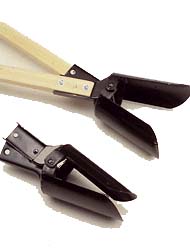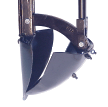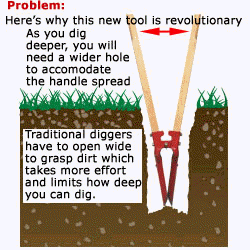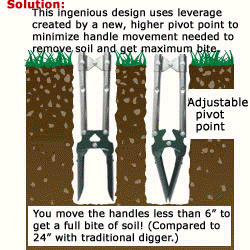|
|
Five
Styles of
Posthole Diggers
In the
U.S. our digs tend to be shallow -- in the 2-3 foot range
is very normal. As a consequence, we are often able to
use a posthole digger to quickly break into a den pipe.
In fact,
the hole made by the posthole digger may not be very
useful. Used in a conventional fashion, the hole made by
a posthole digger is too small to give the dog enough
room to enter properly (or at all), and is also too small
to easily extricate the quarry for dispatch. In addition,
past the two foot depth, the handles of a posthole digger
cannot be pulled wide enough to remove dirt very easily.
In the
end, in order to get a hole big enough to enter a dog or
pull quarry, you have to use a posthole digger to bore
several over-lapping holes. By the time you do this, it's
often easier to use a shovel from the start.
That said,
I still carry a posthole digger on digs where I do not
have to walk too far as I find that a posthole digger is
a very useful tool when used in conjunction with a
shovel.
The trick
is to cut the first 18 inches to two feet of dirt off the
top of the hole, and then use the posthole digger to
drill down the last 18 inches or so. This combination of
tool use yields rapid results, but has to be tempered
against the weight of the posthole digger (12 to 15
pounds) and the distance to be walked -- a real concern
when I am digging alone and it is hot out.
A traditional posthole
digger can be found in most good hardware stores and will
cost $40 to $60. You want a "Hercules-style "
posthole digger that has big and deep jaws, not the
smaller and lighter "Atlas" type which is so
light as to be useless unless you have a few postholes to
dig for a very short fence line. With a posthole digger,
bigger is better.
  |
1. Heavy Duty Traditional Posthole
Digger
This is the type of posthole digger I use. You
want to get a heavy-duty posthole digger with big
blades. I strongly advise people to not get a
cheap lightweight posthole digger -- they
cannot do the job and you are better off buying a
good shovel and not using a posthole digger at
all. The posthole digger
pictured here has one-piece high-carbon steel
blades that have pre-beveled edges for easier
soil penetration. Extra large hinge bolts are
used for improved durability. The handle is
mounting with outside nuts for easy tightening.
The round handle shanks are made of solid Ash,
and the whole thing weighs about 17.5 pounds.
Some heavy-duty posthole diggers now come affixed
to stiff fiberglass handles that
are lighter than the wood ones. These work well
and are easier to carry, but the handles have to
be stiff fiberglass, not flexible, or else they
will spring too much and absorb the impact when
the posthole digger is driven into the ground. A
posthole digger with fiberglass handles will
weigh about 12 pounds as compared to about 17.5
pounds for a heavy-duty wooden-handled posthole
digger of the kind you can get at Home Depot. An
all steel-version of this posthole digger is sold
by Seymour
Manufacturing, but I
do not know the weight.
It should be noted that tools
tend to gravitate towards success, and that the
heavy-duty "Hercules" design shown here
has stood the test of time. This type of posthole
digger is the same style used by telephone pole
installers when they are required to dig very
deep holes by hand. The models sold by Peavy
Tools come with handles as long as 12 feet. The
four alternative style posthole diggers presented
below are "tools of interest," but I
have never used them, nor do I know anyone who
has.
|
Purchase Option 1
Purchase Option 2
Purchase Option 3
|
 |
2. Split
Handled Posthole Digger
I have never actually used this type of digger,
which is sold by Osh Kosh Tools. The blades are
attached by welding instead of riveting
"making a durable joint with no rivets to
shear off." The fulcrum members are made of
heavily constructed, channel-shaped steel –
no castings (this is good??). The diameter of the
circle circumscribed by the digger blades is
about 6 inches. Two bolts hold each handle to the
digger head making them easy to replace when
necessary. The Split handles are used with a
front to back motion. Though an interesting
design, I am not sure that it is a marked
improvement over the more traditional posthole
digger, and the blades pictured here look a bit
light to me. As a general rule, shaped or stamped
steel is inferior in strength to cast steel. |
Purchase Option 1 |
 |
3. Erie Hole Digger aka the
"Boston Digger"
I have never actually seen this type of
digger used. It is described as a "Universal
design that digs effectively in gravel and stony
soils." The tool is said to be effective at
"dislodging stones, cutting roots, sizing
and shaping holes." The idea here is that
the single point drives down and dislodges the
dirt, and the levered-scoop is then hinged down
to collect the dirt and pull it up. This sounds
like a more complicated motion than you have with
a traditional posthole digger. The tool also has
more moving parts, and I wonder about its
durability under the conditions in which we dig.
This is not a cheap tool to buy. It is described
as coming with "a Canadian hardwood
shank" (Ash I suspect), steel arm with
6" blades, powder coat, and urethane finish.
Depth markings are inscribed on the shank at
24", 36" and 48". This tool weighs
15 pounds.
|
Purchase Option 1 Purchase Option 2
|
 |
4. The Hole Deal
I have never actually seen this type of digger
used. Gemplers, the professional
farming-tool-supply company, is featuring "The
Hole Deal" tool as
a new innovation. They write: "We were
amazed no one thought of this until now. This
commercial-grade posthole digger is superior to
all others because it has a hinged leverage point
that allows you to open and close the digger with
minimal hand movement. Its unique design allows
you to dig straight-sided holes of any diameter
and as deep as 5 feet with only 4" to
6" handle travel. It requires much less
effort to operate and needs much less clearance
above or near the hole. Adjustable handle pivot
increases blade leverage for compacted soils.
Carbon steel blades have better edge retention
and longer life. Steel handles. Overall length is
59"." It weighs 14-1/2 lbs and is made
in the USA. This is a
very interesting design, and I would like to hear
from someone that has actually used this tool in
the field under a variety of conditions. Does it
work? Does the tool hold up to the kind of abuse
we give our tools?


|
Purchase Option 1 Purchase Option 2
Purchase Option 3
|
 |
5. All-Metal Posthole Diggers
I have never actually seen this type of
digger used. The one pictured to the left is sold
by a Swedish company called Fiskars which says
the "narrow handle profile allows for more
productive digging, with less interference from
the edge of the hole." I do not think this
is actually true, as handle-width is not really a
problem with a traditional posthole digger. I do
know that the handles on this product are not
replaceable. The handle design seems a bit
awkward for driving the blades into the ground
full-force -- perhaps I am wrong about this.
Construction is of welded steel with 12-gauge
hardened steel blades that are already sharpened.
The blade spread is 6". A similar product in
made my Bulldog tools in the UK and sold by Greenham Tools
as a "shovel-holer". Another all-steel
post hole digger with off-set handles is the
American-made "Buckeye Post Hole Digger" which weighs 16 pounds. As noted
at the top of the page, Seymour tools also makes
a traditional posthole digger design with
all-metal arms
|
Purchase Option 1 Purchase Option 2
|
|
|





